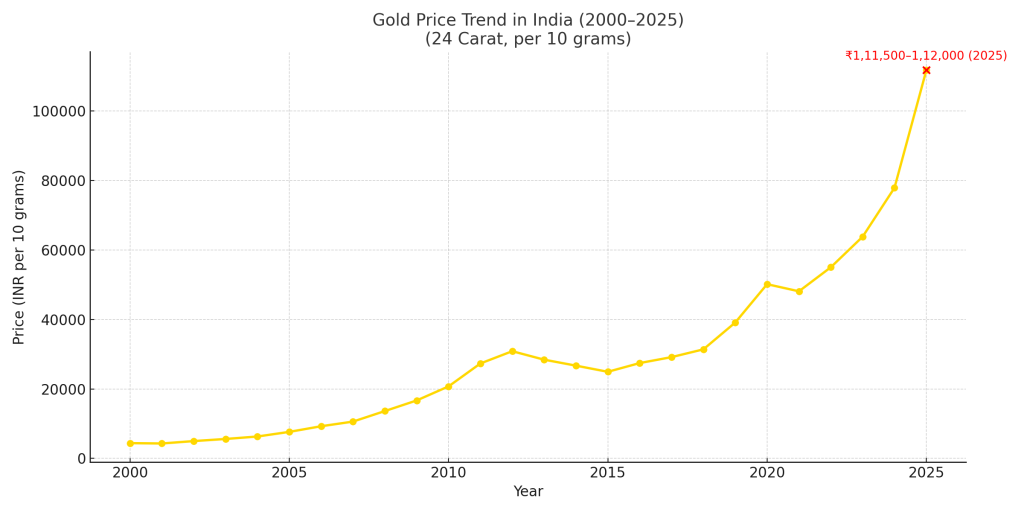
Gold in India isn’t just a commodity–it’s an investment, a tradition, and a form of financial security. As we move deeper into 2025, gold prices in India have surged to record highs, sparking concern for buyers but also creating opportunities for investors. Understanding what’s driving this rally and how it affects households, investors, and the economy can help you make smarter financial choices.
Several global and domestic factors are behind the sharp upward trend:
1. Federal Reserve Policies
Recent U.S. economic signals—slowing job growth and easing inflation—have raised expectations of a Federal Reserve interest rate cut. When global interest rates fall, returns from bonds and savings weaken, leading investors worldwide to shift funds into gold.
2. Inflation and Rupee Weakness
Gold is a proven hedge against inflation. With higher import costs due to a weaker rupee against the U.S. dollar, Indian buyers are directly impacted. Since India imports most of its gold, even small currency fluctuations push prices up.
3. Safe-Haven Demand Amid Geopolitical Tensions
Global uncertainties—trade disputes, war risks, political instability—are boosting safe-haven buying. Central banks across countries, including India, have been increasing gold reserves (source: RBI).
4. Investment Demand vs Jewellery Demand
Jewellery demand has dipped as prices rise, but gold Exchange Traded Funds (ETFs), bars, and coins are seeing robust inflows. According to the World Gold Council (source), central bank buying has remained one of the strongest drivers of gold demand in 2025.
5. Profit-Taking and Technical Corrections
After record highs, some pullbacks occur when traders book profits. Recently, MCX futures witnessed minor corrections after touching all-time highs.
6. Forecasts & Price Sentiment
Analysts forecast that gold could cross $3,800 per ounce by end-2025 and potentially touch $4,000 in 2026. In India, this could mean ₹1,12,000+ per 10 grams in the coming year if the trend continues.

Households & Jewellery Buyers
High prices mean consumers are purchasing lighter jewellery, mixing gold with other metals, or delaying big-ticket wedding purchases. Reports suggest jewellery demand in 2025 could fall to a 5-year low despite the festive season.
Investors
For long-term investors, this surge is positive. Gold ETFs, digital gold, and sovereign gold bonds are becoming more attractive compared to jewellery due to lower costs and better liquidity.
Borrowers Using Gold as Collateral
Higher prices mean gold pledged for loans has a higher collateral value. For households in need of liquidity, this provides more borrowing power.
Jewellery Industry & Artisans
Rising gold squeezes margins for jewellers who struggle to pass on costs to consumers. Smaller jewellers and artisans face declining demand in high-price periods.
Indian Economy
Gold imports widen the trade deficit, putting pressure on foreign reserves and the rupee. However, the RBI’s gold holdings gain in value, strengthening the balance sheet of the central bank.
Despite the surge, festivals like Diwali, Dhanteras, and Akshaya Tritiya will continue to see gold buying, even if in smaller quantities. Indians consider gold a symbol of wealth and prosperity.
However, buying habits are changing:
Pre-purchasing before festivals to avoid peak pricing.

Here are practical strategies:
Use an EMI Calculator for Gold Purchases
If you’re buying jewellery on instalments, use our Gold Loan EMI Calculator to estimate monthly outflows and manage budgets better.
Gold prices in India 2025 are expected to remain elevated due to global uncertainties, central bank buying, and rupee weakness. While this puts pressure on households and jewellers, it also creates opportunities for investors.
Whether you are planning a wedding purchase, exploring gold as an investment, or considering alternatives like ETFs and SGBs, the key is timing and diversification.
Stay informed, plan ahead, and use financial tools like EMI and SIP calculators to make smarter decisions in this volatile environment.